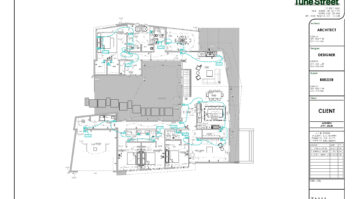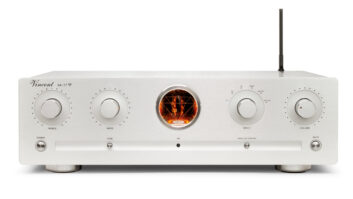Almost as important as specifying the best products for your clients is finding a place to put those products. Unlike the owners of commercial facilities–who, in many cases, dont mind if an equipment rack looks like an equipment rack–homeowners generally want their newly installed A/V technology to remain invisible, or at least to blend in with the dcor.
As a result, custom installation companies must not only be proficient at implementing sophisticated, high-tech systems, but they must also know a thing or two about cabinetry and working with cabinetmakers.
Jon Litt, president of Custom System Technologies (CST), an Austin-based custom installation company (www.cstaustin.com), explains that his team asks clients to point out the faults in their current cabinetry to help them come up with a good design. “What we try to take into consideration is not only the placement of the cabinetry, but also how the client is going to use it,” he explained.
“One question we ask in the beginning is what kind of system the client has in their current home, and what they like about it versus what they dont like about it. Usually, what that dont like about it is that they have to bend down to get to the equipment, or they cant get to the equipment, its difficult to clean and organize, or it may overheat.”
Millson Multi-Media Inc., a custom installation firm based in Vancouver, Canada (www.millson.net), works with a number of cabinetmakers, but also has succeeded in developing a close relationship with SOMA Furniture, a local high-end furniture and millwork shop (www.somafurniture.net). “We will do the drawings, the conceptual design, and we will work things through with the client. Then we will oversee the construction of the cabinets and will then install everything,” explained Richard Millson, president of Millson Multi-Media.
“Rather than trying to re-educate the various millwork companies that we interface with on different projects, we thought, Why not choose a high-quality millwork company and bring them into the fold, rather than trying to reinvent the wheel each time? They already know the cooling requirements, the wire pathways, how wide an equipment rack is, what we must do to support a sliding rack…all of those sorts of things.”
Millson emphasizes that the secret to ensuring that everything is built to specification the first time is to maintain strong communications. “If there are changes, they must be documented immediately; dont assume that just because you sent requirements or equipment sizes over that they are going to get interpreted correctly,” he said. “They almost never do, unless the people that you are working with understand A/V and how it integrates with millwork.”
At SOMA Furniture, the shop that works with Millson on a regular basis, the details that Millson Multi-Media provides help the cabinetmakers to get things right the first time. “One of the things that works really well with the relationship that I have with Millson Multi-Media is that we communicate well together,” noted David Rootman, principal at SOMA, which he runs in conjunction with business partner Clive Corfield. “They give us information on what they are actually putting into the cabinets as well as information on their requirements as far as wiring and ventilation, as well as sound absorption.”
Charlie Colwell, president of Artistic Systems in Telluride, Colorado (www.artisticsystems.net), insists that his company have signing power on the cabinet designs before construction begins. “The main mistake that is made is trusting that when you give a specification to someone, that they will actually follow that specification,” he said. “The trick to making sure that its right is to demand that you have authority to sign off on the final cabinet drawing before its built.”
Good communication is especially important when there are inevitable change orders during a project. “We have seen many mistakes where we have allowed for a 50-inch plasma screen and then the model is changed partway through the project. That must be caught and flagged as a change, and the cabinetmaker must be notified,” Millson said. “It doesnt work if you give the information to the general contractor. You must contact the cabinetmaker directly, go to their shop, and present them with the new information. In short, we have to be extremely proactive. When we are, we get great results. If we assume that they know what they should be doing, we dont.” Millson adds that the less experienced the mill worker is with building cabinets for A/V gear, the more important this is.
Millson observes that as A/V systems become less bulky, so, too, are the cabinets that house them. “The design is very clean and less ornate; there are less finicky details. This goes hand in hand with the trend toward flat-screen displays, whether it is LCD or plasmas. They take up less space, so people dont want to build a big, deep cabinet,” he said. “The rest of the millwork around the display, therefore, doesnt need to be large and bulky because they are not dealing with the depth of a normal TV. Its a cleaner and more streamlined approach.”
Dark colors help to conceal technology, giving the systems a homier, more integrated look. “We tend to hide flat panel speakers with fabric for a very clean appearance. We are also seeing darker woods: mahogany, browns, and chocolates; this tends to integrate nicely with darker fabrics to cover speakers,” Millson explained. “When people do things with a light beige or tan, its hard to cover it with fabric without seeing the speaker or the frame behind it. We like to use dark fabrics, which tend to work nicely with darker-colored woods.”
Colwell notes that, just like the specification of audio/video systems, the management of cabinetry design and installation must be included in the price of the overall project. “If you are laying out a project that you know is going to include cabinetry that you are not providing, you need to make sure to include some design time for interfacing with the architect, the builder, the cabinetmaker, and the client,” he pointed out.
To facilitate an efficient, profitable installation, and to ensure that your clients are happy in the end, it is best to cultivate a relationship with a local millwork shop, Millson advised. “I would encourage A/V dealers to find the high-quality woodworker in their area and forge that relationship with them,” he said. “Each can bring the other into projects, so there is that possibility for recommendations or referrals. There is also the potential for reduced headaches and hassle for having to re-communicate the same ideas to a new mill worker for each project. They become your partner, and that becomes invaluable in terms of managing the overall project.”
In cases where the cabinetmaker and the custom installation firm are working together for the first time, developing a team spirit is essential, Colwell noted. “The key to dealing with any subcontractor is to keep it positive,” he said. “A lot of times, people arent thrilled when someone comes in and tells them how they should be doing their job. We try hard to approach it from a team perspective: we are tasked together to get this done. It may be tough, but the end result is the client will get a quality product.”
Carolyn Heinze ([email protected]) is a freelance writer/editor.







